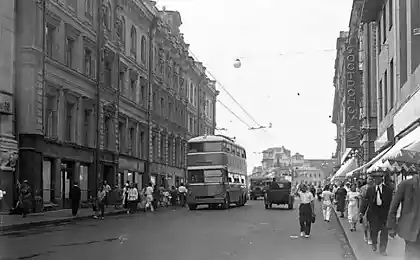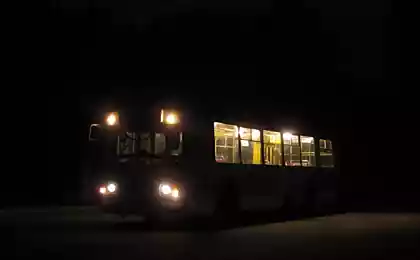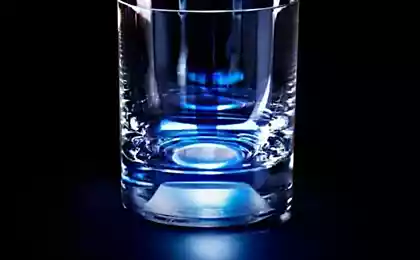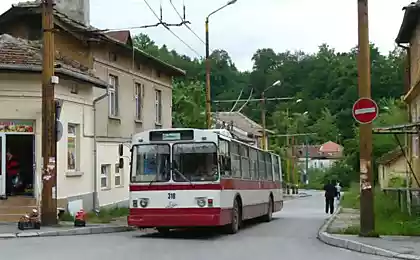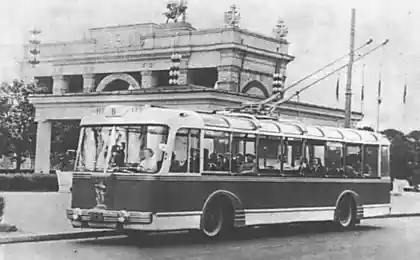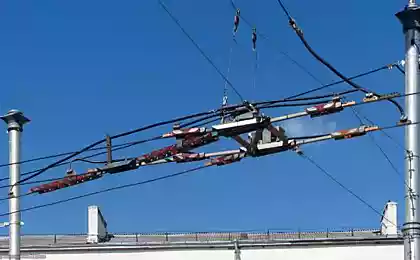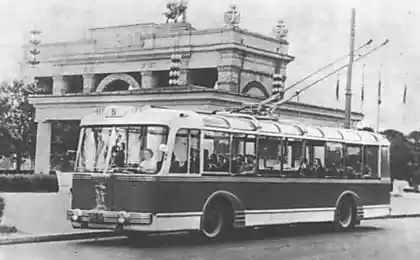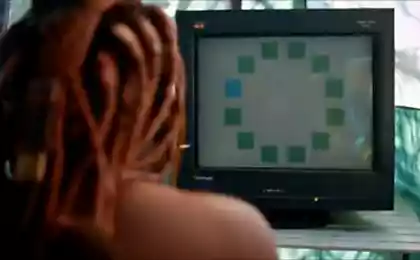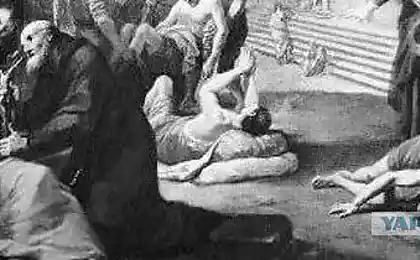981
"The same" blue trolley
Ilya Varlamov and Dmitry Chistoprudov tell about the legendary blue trolley MTB-82, which they filmed in the 7th trolleybus park. It praised the trolley Okudzhava in the eponymous song
When I could not endure overcome misfortune,
when creeping despair,
I'm blue trolley bus on the run,
the last in random.
31 phot
1. Today, in the 7th trolleybus park is the legendary "blue trolley" MTB-82, sung Okudzhava in the eponymous song. Presented trolley bus number 1777 after write-off was used as the cabins in one of the resorts. Now it is restored.
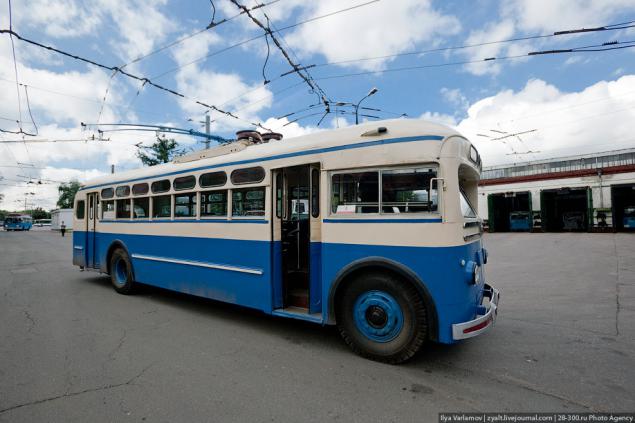
2. The construction of the cargo fleet with 150 parking spaces on Nagatinskaya highway began in 1962, but in the process of completion, it was decided to use it also for the operation of passenger cars. October 30, 1964 out of the gate of the park out the first three cargo trolley and on 11 November the same year the route №40 - the first passenger car. Now the fleet of 250 vehicles.
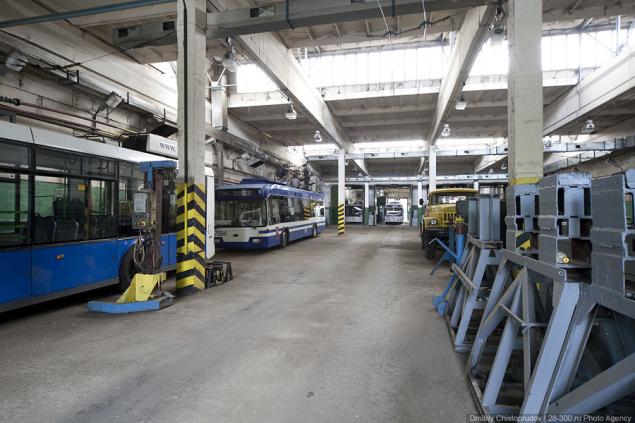
3. In the territory of 6 hectares is an open parking lot, industrial and administrative buildings, fuel storage, workshop-dispensary, rolling stock repair shop, a dining room, a dispensary. Gateway boxes are equipped with air curtains, and the gates of the park - a mechanical drive. Feed consisting of 3 lines, designed for 5 cars each.
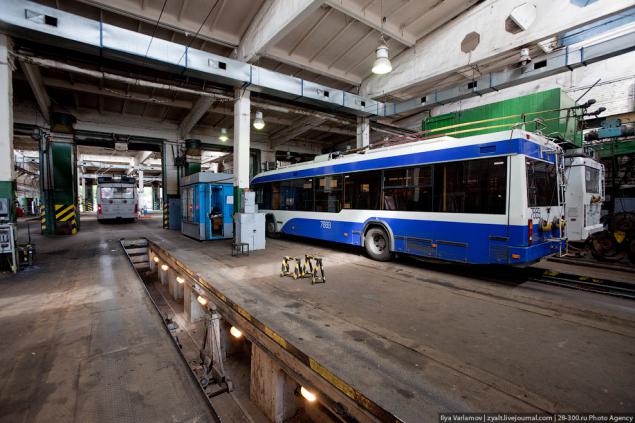
4. For many of the older generation of MTB-82 - is the one memorable "blue trolley", a lyrical image of the bygone era. Indeed, at one time it was virtually the only model of the Soviet trolley. Appearing immediately after the war, he dominated the streets of our cities every 50th and much of the '60s, until it was replaced by more modern ZiU and "Skoda". The body design of trolley MTB-82 borrowed from the American Bus "General Motors" 1940 release.

5. In the summer of 1941, after the start of World War II, the production of the old trolley YATB at the Yaroslavl automobile plant was stopped, and it was edinsvennoe factory producing trolley. During the war they destroyed many cars and replace them as there was nothing, as new trolleybuses were not issued. The country needed the most technologically simple and rolling stock, because after the war the overall level of qualification of the personnel of transport enterprises was often not sufficient for the operation of complex machines.

6. Development and production of new vehicles have been assigned the plant number 82 the People's Commissariat of Aviation Industry in the suburban Tushino. The new machine - MTB-82 - got its index of factory rooms, the acronym also means "Moscow trolleybuses." It should be noted that in Soviet times classified military enterprises, which have been set, assigned a number instead of name, to undertakings concerned and the Tushino factory.
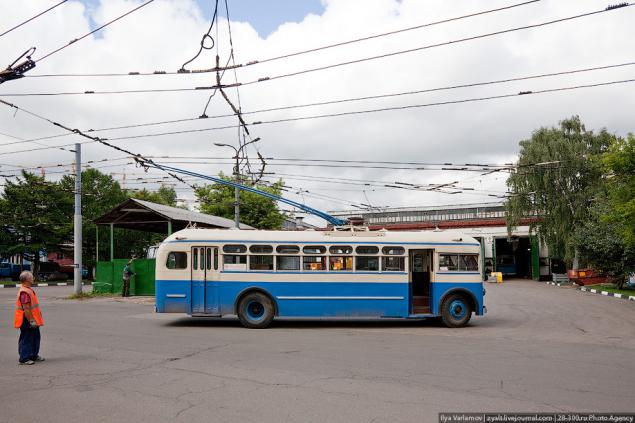
7. MTB-82 essentially is a continuation of a series of Yaroslavl trolley. It was created on the basis of not recycled in a series of trolley YATB-5 and drawings for unbuilt YATB-6, which, in turn, had much in common with the bus of the American company "General Motors". Design trolley was also largely similar to the prewar cars Yaroslavl.
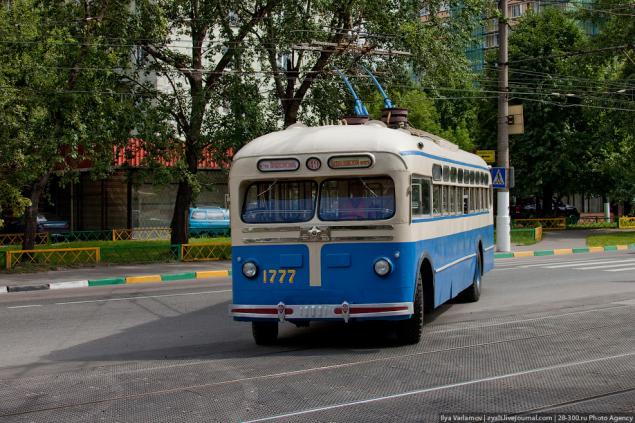
8. The main innovation in the design of the pre-war trolleybuses became the all-metal housing made of riveted steel plates, aluminum body has become (a legacy of the specifics of the aviation plant). Capacity trolley by today's standards seem small - 65 people, but in those days it was enough for a city trolley.
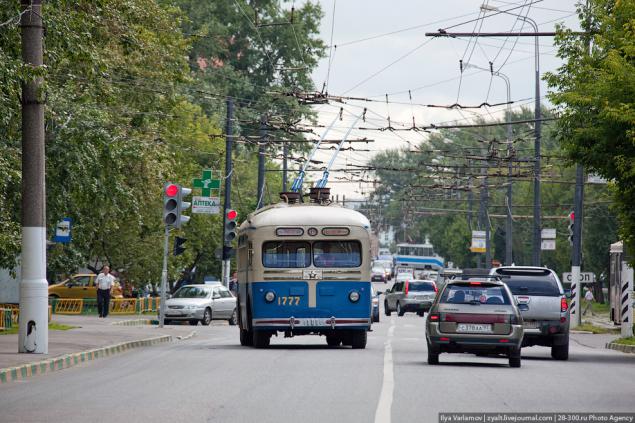
9. In 1950, the production of trolleybuses in Tushino plant was curtailed due to conversion of enterprises and resumed only after half a year in the new factory Uritsky Engels in the Saratov region. Despite this, the index of the model remained the same until the end of the issue in 1961. Externally, the trolley also has not changed, only the Tushino factory emblem on the front of a trolley bus was replaced by a five-pointed star.

10. In the mid-1950s it became clear that the MTB-82 no longer satisfies the requirements of the time, in spite of all its advantages. Antebellum design fully exhausted the reserves of its development. On the agenda was a question on the development of a large class of trolleybuses with a monocoque body, automatic current control through TED, the implementation conditions of increased travel comfort for passengers and driver convenience.

11. In areas where trolley routes diverge, rather than automatically switching "arrows" on the wires, the driver had to climb onto the roof of the trolley to the rope and use them to rearrange the susceptor.
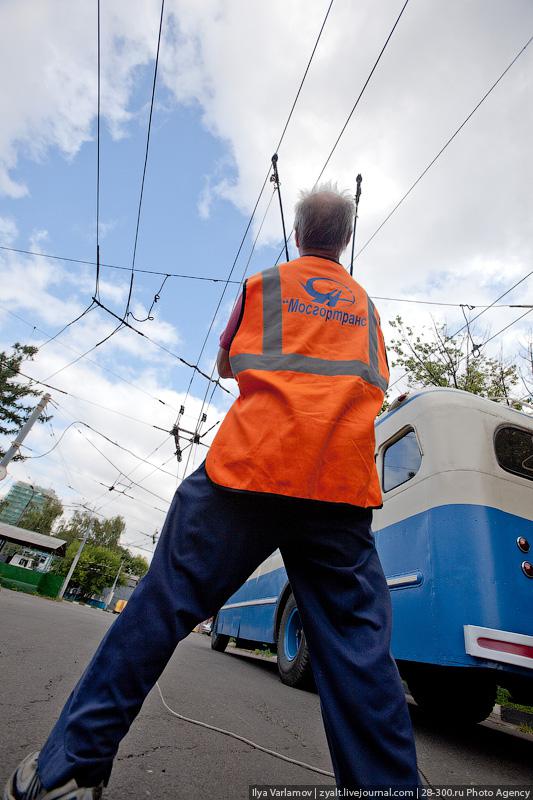
12
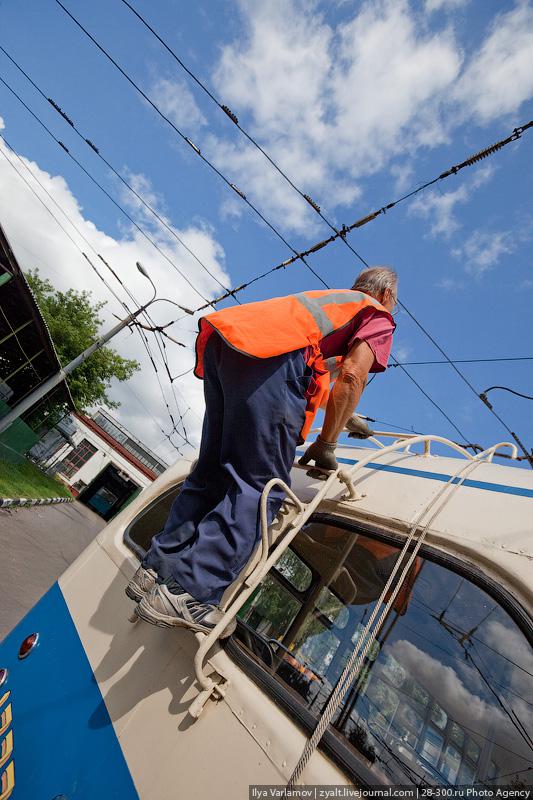
13
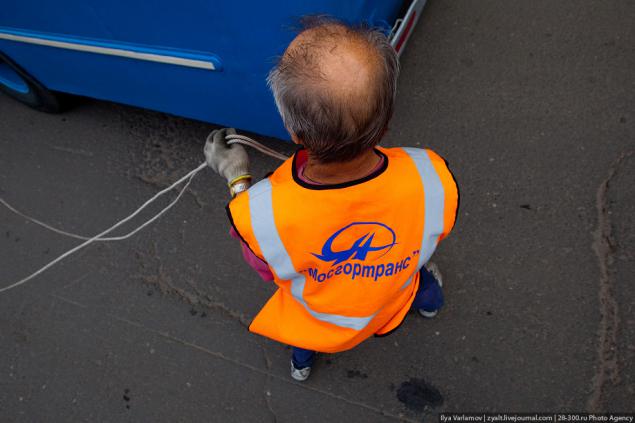
14
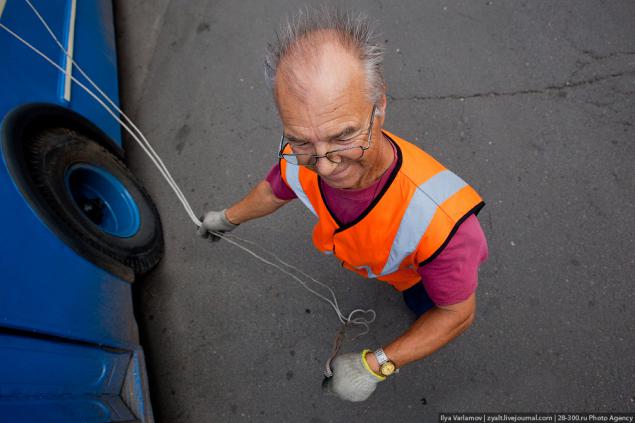
15. Then again, it was necessary to climb in order to put back the rope.

16. For 14 years, was released around 5000 MTB-82 trolleybuses. The body of this trolleybus was the basis for the creation of no less than the legendary tram car - MTV-82. For a long time it was the only model of trolley, produced in the USSR. She was so widespread that in the 50s the word "trolley" for many residents of the Union associated with this machine. In many cities, other models trolley just was not until the early 60-ies.

17. With regard to comfort MTB-82 does not stand any criticism - the narrow doors and pass through the center of the cabin, small windows, the lack of forward accumulation area, a disproportionate and winter-frozen through the driver's cab. All this was due to the fact that at the time the MTB-82 was only a matter of ensuring the transport of passengers, and comfort requirements of the trip is almost not taken into account.
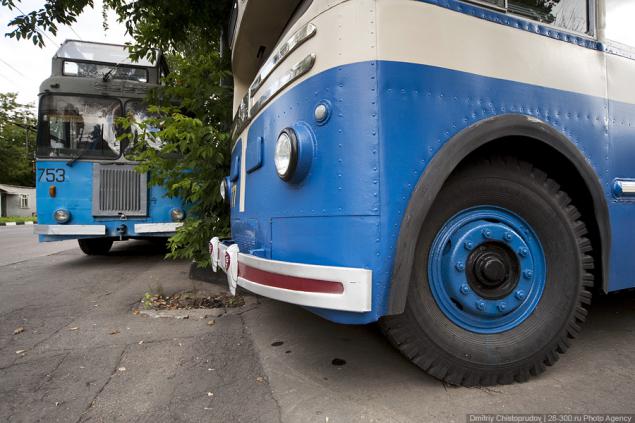
18. Planting was carried into the cabin through the door platen width 570 mm, one of which is located immediately behind the front axle, and the second - in the rear overhang. Both doors were equipped with a pneumatic actuator. Side windows in the passenger compartment of a small size, consisting of two parts, the lower portion can rise upwards and be secured at different heights special latches.
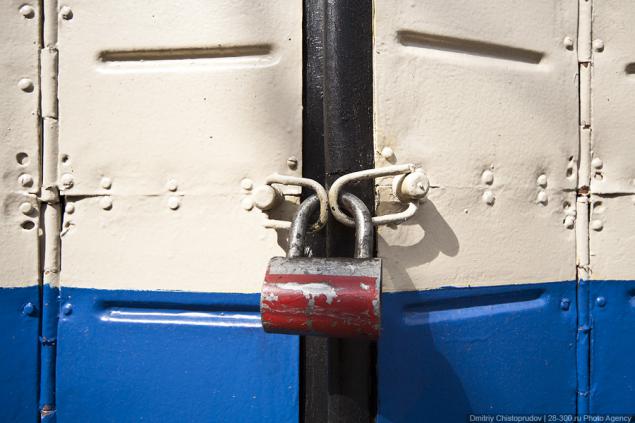
19. The driver occupies the entire space in front of the front door.

20

21. Comfort passengers when traveling by MTB-82 almost was not. Very narrow front door and no accumulation area made it difficult to input and output, transport oversized luggage or pram.
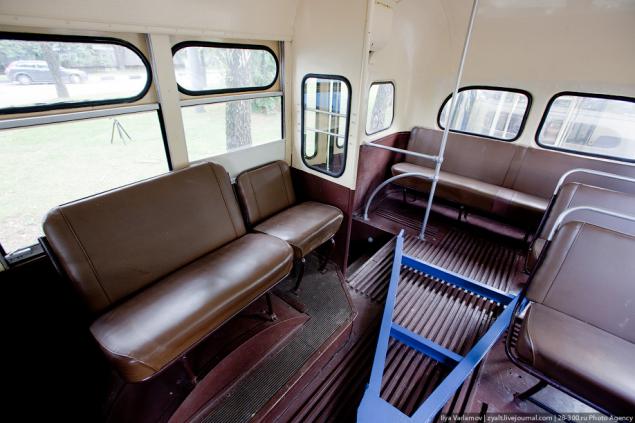
22. Passage between two-row seats in the middle of the cabin was narrow, and the seats themselves were located very close to each other. Total seats were 38 passengers, about 50 more people could ride standing at a maximum loading trolley. Often ozle back door was equipped with the place of the conductor, which is separated from the door by a glass partition.
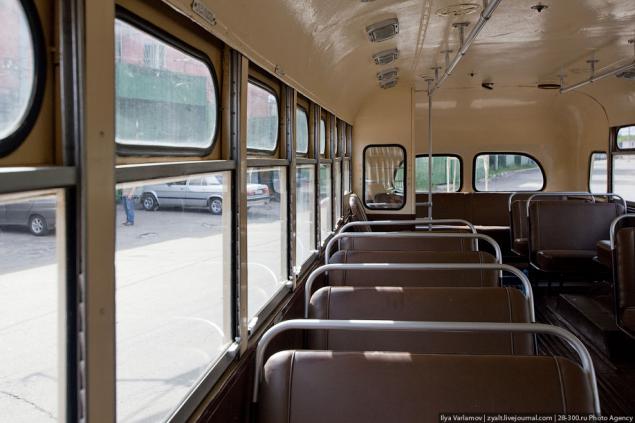
23. Low windows unobstructed view of standing passengers (in the absence of point radio broadcasts had no way of knowing the right stop, but to look into the window), low ceiling made it difficult to travel for people of high growth.

24
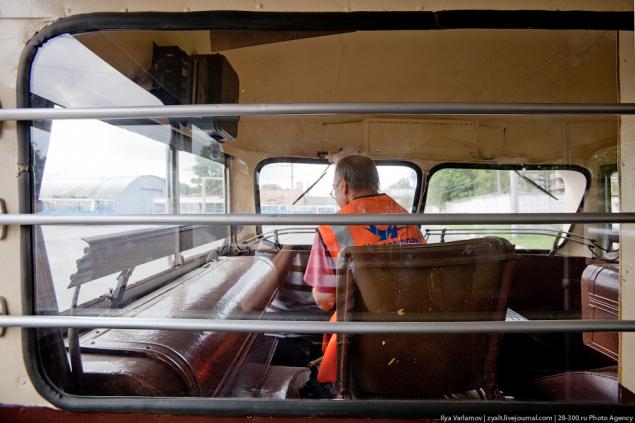
25

26. Drivers veterans skeptical and sometimes even to the point of mockery told newcomers that ZiU-5 and 9-ZiU same sissy as novice drivers. As a kind of "aptitude test" was proposed to launch a newcomer to the line for a long time standing in reserve MTB-82, which has "grown grass in the cabin." Good knowledge of the art, simple device MTB-82 and his simple tastes to environmental conditions made the task difficult, though, but quite feasible. ZiU-5 and ZiU-9 after a long downtime required far more serious intervention. However, this list of advantages of MTB-82 ended.

27. Power Steering on the MTB-82 was absent, requiring the driver a lot of physical strength and endurance. Also, the driver was required to accurately perform the switching time sequence starting resistances during acceleration. Although the control system had protection from misuse of their inclusion, but each position controller had a definite limit on time. It was fraught with excess overheating and combustion puskotormoznyh resistance. From running position is only the 8th and 11th were allowed unlimited time traffic, so possession of the pedal stroke from the driver MTB-82 should be honed to automaticity. Constant change in the positions of controller Ramp is not the best way affects driver fatigue.

28

29
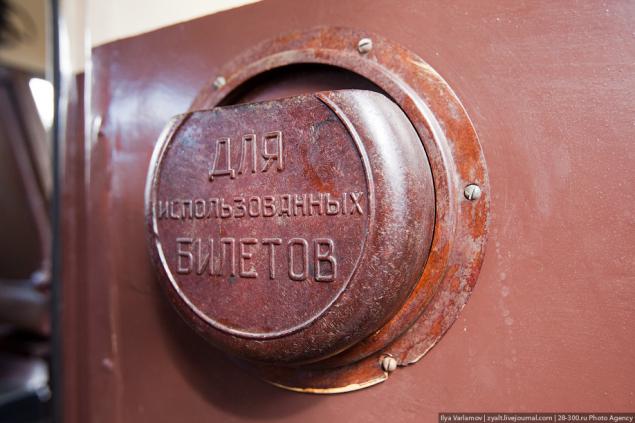
30
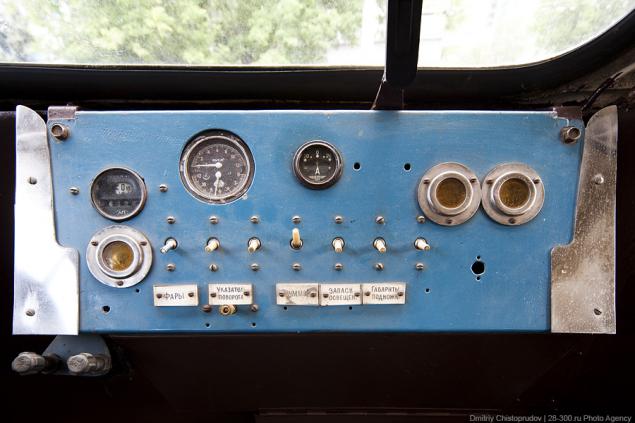
31

Source:
When I could not endure overcome misfortune,
when creeping despair,
I'm blue trolley bus on the run,
the last in random.
31 phot
1. Today, in the 7th trolleybus park is the legendary "blue trolley" MTB-82, sung Okudzhava in the eponymous song. Presented trolley bus number 1777 after write-off was used as the cabins in one of the resorts. Now it is restored.

2. The construction of the cargo fleet with 150 parking spaces on Nagatinskaya highway began in 1962, but in the process of completion, it was decided to use it also for the operation of passenger cars. October 30, 1964 out of the gate of the park out the first three cargo trolley and on 11 November the same year the route №40 - the first passenger car. Now the fleet of 250 vehicles.

3. In the territory of 6 hectares is an open parking lot, industrial and administrative buildings, fuel storage, workshop-dispensary, rolling stock repair shop, a dining room, a dispensary. Gateway boxes are equipped with air curtains, and the gates of the park - a mechanical drive. Feed consisting of 3 lines, designed for 5 cars each.

4. For many of the older generation of MTB-82 - is the one memorable "blue trolley", a lyrical image of the bygone era. Indeed, at one time it was virtually the only model of the Soviet trolley. Appearing immediately after the war, he dominated the streets of our cities every 50th and much of the '60s, until it was replaced by more modern ZiU and "Skoda". The body design of trolley MTB-82 borrowed from the American Bus "General Motors" 1940 release.

5. In the summer of 1941, after the start of World War II, the production of the old trolley YATB at the Yaroslavl automobile plant was stopped, and it was edinsvennoe factory producing trolley. During the war they destroyed many cars and replace them as there was nothing, as new trolleybuses were not issued. The country needed the most technologically simple and rolling stock, because after the war the overall level of qualification of the personnel of transport enterprises was often not sufficient for the operation of complex machines.

6. Development and production of new vehicles have been assigned the plant number 82 the People's Commissariat of Aviation Industry in the suburban Tushino. The new machine - MTB-82 - got its index of factory rooms, the acronym also means "Moscow trolleybuses." It should be noted that in Soviet times classified military enterprises, which have been set, assigned a number instead of name, to undertakings concerned and the Tushino factory.

7. MTB-82 essentially is a continuation of a series of Yaroslavl trolley. It was created on the basis of not recycled in a series of trolley YATB-5 and drawings for unbuilt YATB-6, which, in turn, had much in common with the bus of the American company "General Motors". Design trolley was also largely similar to the prewar cars Yaroslavl.

8. The main innovation in the design of the pre-war trolleybuses became the all-metal housing made of riveted steel plates, aluminum body has become (a legacy of the specifics of the aviation plant). Capacity trolley by today's standards seem small - 65 people, but in those days it was enough for a city trolley.

9. In 1950, the production of trolleybuses in Tushino plant was curtailed due to conversion of enterprises and resumed only after half a year in the new factory Uritsky Engels in the Saratov region. Despite this, the index of the model remained the same until the end of the issue in 1961. Externally, the trolley also has not changed, only the Tushino factory emblem on the front of a trolley bus was replaced by a five-pointed star.

10. In the mid-1950s it became clear that the MTB-82 no longer satisfies the requirements of the time, in spite of all its advantages. Antebellum design fully exhausted the reserves of its development. On the agenda was a question on the development of a large class of trolleybuses with a monocoque body, automatic current control through TED, the implementation conditions of increased travel comfort for passengers and driver convenience.

11. In areas where trolley routes diverge, rather than automatically switching "arrows" on the wires, the driver had to climb onto the roof of the trolley to the rope and use them to rearrange the susceptor.

12

13

14

15. Then again, it was necessary to climb in order to put back the rope.

16. For 14 years, was released around 5000 MTB-82 trolleybuses. The body of this trolleybus was the basis for the creation of no less than the legendary tram car - MTV-82. For a long time it was the only model of trolley, produced in the USSR. She was so widespread that in the 50s the word "trolley" for many residents of the Union associated with this machine. In many cities, other models trolley just was not until the early 60-ies.

17. With regard to comfort MTB-82 does not stand any criticism - the narrow doors and pass through the center of the cabin, small windows, the lack of forward accumulation area, a disproportionate and winter-frozen through the driver's cab. All this was due to the fact that at the time the MTB-82 was only a matter of ensuring the transport of passengers, and comfort requirements of the trip is almost not taken into account.

18. Planting was carried into the cabin through the door platen width 570 mm, one of which is located immediately behind the front axle, and the second - in the rear overhang. Both doors were equipped with a pneumatic actuator. Side windows in the passenger compartment of a small size, consisting of two parts, the lower portion can rise upwards and be secured at different heights special latches.

19. The driver occupies the entire space in front of the front door.

20

21. Comfort passengers when traveling by MTB-82 almost was not. Very narrow front door and no accumulation area made it difficult to input and output, transport oversized luggage or pram.

22. Passage between two-row seats in the middle of the cabin was narrow, and the seats themselves were located very close to each other. Total seats were 38 passengers, about 50 more people could ride standing at a maximum loading trolley. Often ozle back door was equipped with the place of the conductor, which is separated from the door by a glass partition.

23. Low windows unobstructed view of standing passengers (in the absence of point radio broadcasts had no way of knowing the right stop, but to look into the window), low ceiling made it difficult to travel for people of high growth.

24

25

26. Drivers veterans skeptical and sometimes even to the point of mockery told newcomers that ZiU-5 and 9-ZiU same sissy as novice drivers. As a kind of "aptitude test" was proposed to launch a newcomer to the line for a long time standing in reserve MTB-82, which has "grown grass in the cabin." Good knowledge of the art, simple device MTB-82 and his simple tastes to environmental conditions made the task difficult, though, but quite feasible. ZiU-5 and ZiU-9 after a long downtime required far more serious intervention. However, this list of advantages of MTB-82 ended.

27. Power Steering on the MTB-82 was absent, requiring the driver a lot of physical strength and endurance. Also, the driver was required to accurately perform the switching time sequence starting resistances during acceleration. Although the control system had protection from misuse of their inclusion, but each position controller had a definite limit on time. It was fraught with excess overheating and combustion puskotormoznyh resistance. From running position is only the 8th and 11th were allowed unlimited time traffic, so possession of the pedal stroke from the driver MTB-82 should be honed to automaticity. Constant change in the positions of controller Ramp is not the best way affects driver fatigue.

28

29

30

31

Source:
